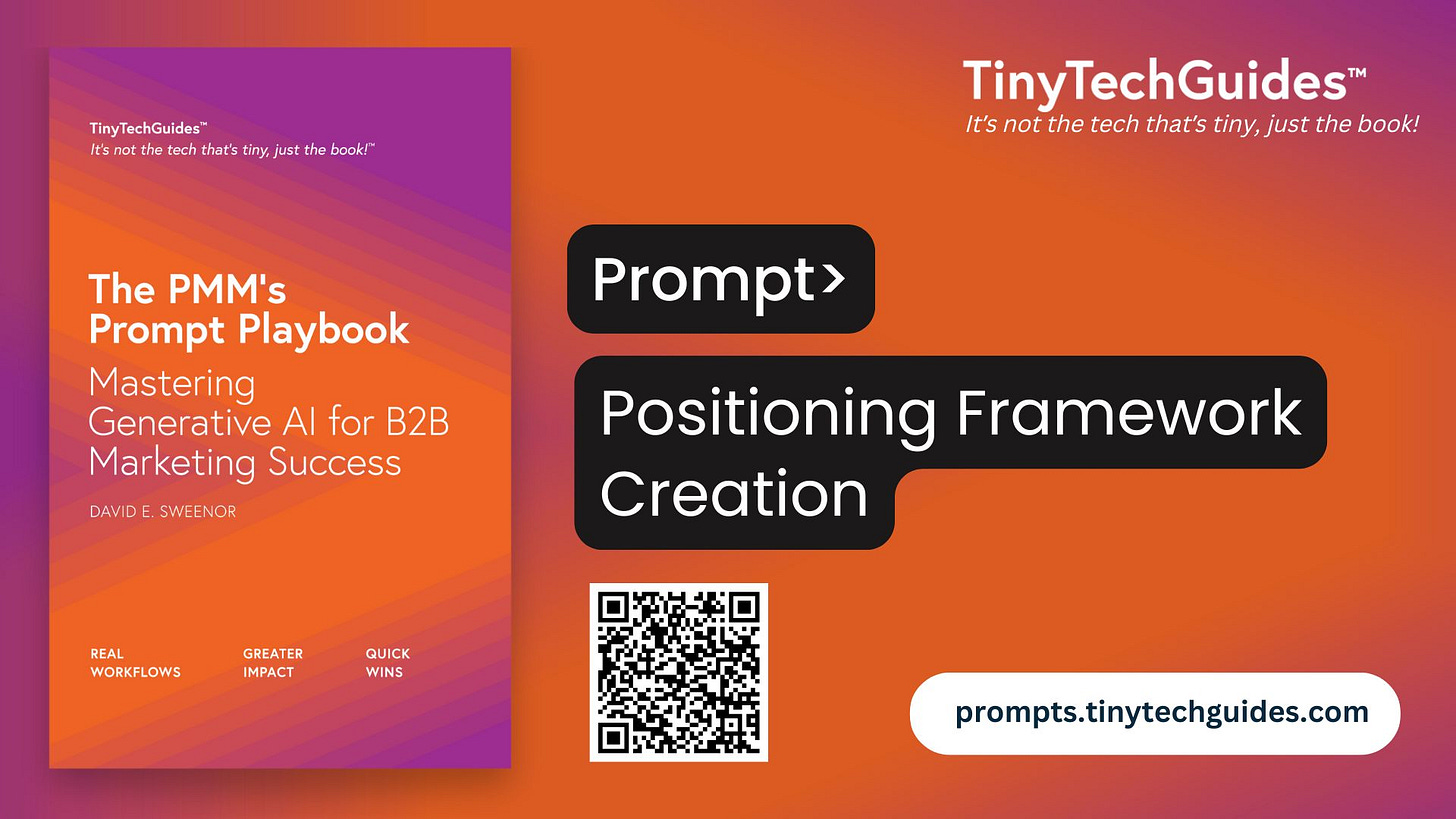Prompt Workflow: Build a B2B Positioning Statement That Sticks
Use Geoffrey Moore’s proven framework to define your audience, differentiation, and category — in one structured workflow.
This bonus prompt is part of The PMM’s Prompt Playbook which has 30 ready-to-use prompts. If you're looking for more cut-and-paste prompts, join the Substack! Paid subscribers receive new cut-and-paste prompts every week.
Get the PMM’s Prompt Playbook and Modern B2B Marketing today!
You can download a messaging framework template adapted from Moore’s original work at TinyTechGuides.com/Templates.
What does this do?
The Positioning Framework Creation workflow helps businesses craft a clear and compelling positioning statement that defines their target audience, key differentiators, and competitive advantage. Using Geoffrey Moore’s Positioning Model, this process ensures that product messaging is precise, relevant, and differentiated from competitors. The framework serves as a foundation for marketing, sales, and product strategy alignment.
Workflow steps
Define the target customer and their core problem
Identify the product category and unique value proposition
Analyze competitors and refine differentiation
Craft a positioning statement using Moore’s structured framework
Validate the positioning statement for clarity and market relevance
Align the positioning with messaging, sales enablement, and go-to-market strategy
Define the inputs
{industry=Insert your target industry, e.g., enterprise cloud security.}{solution=Insert your product/solution, e.g., cloud-based threat detection platform.}{target audience=Insert primary audience, e.g., CISOs, IT security leaders, DevOps engineers.}{competition=Insert key competitors, e.g., Competitor A, Competitor B.}
Define the objective
<role/>
You are a product marketing expert specializing in positioning strategies for {industry}.
</role>
<context/>
I need to develop a positioning framework for {solution} using Geoffrey Moore’s Positioning Model. This will help clarify our target audience, differentiators, and value proposition relative to competitors.
</context>
<task/>
Based on Moore’s framework, create a positioning statement that answers the following:
-**Target customer**: Who is the ideal customer for {solution}?
-**Problem**: What pressing problem or challenge does the target customer face? 3. **Product Category**: What category does {solution} belong to?
-**Unique value**: What is the key differentiator or benefit {solution} offers?
-**Competition**: Who are the key competitors, and how is {solution} better?
Combine these into the following structure:
“For [target customer], who face [key problem], [solution] is a [product category] that provides [unique value]. Unlike [competition], our product [key differentiator].”
</task>
<format>
Provide the completed positioning statement and include a breakdown of each component for clarity:
Target Customer: [Brief description].Problem: [The specific challenge being addressed].Product Category: [The category {solution} fits into].Unique Value: [The primary differentiator or key benefit].Competition: [Key competitors and how {solution} outperforms them].Final Positioning Statement:
“For [target customer], who face [key problem], [solution] is a [product category] that provides [unique value]. Unlike [competition], our product [key differentiator].”
</format>
<tone>
Clear, structured, and market-focused.
</tone>
Identify the target customer and problem
<role/>
You are a customer insights analyst defining the target audience and their core challenges for {solution}.
</role>
<context/>
To build the positioning framework, I need to clearly articulate the target customer and the problem they face. Focus on identifying the audience that will benefit most from {solution} and the specific challenge they encounter.
</context>
<task/>
Answer the following questions:
-Who is the **primary target audience** for {solution}? Include role/title, company size, and industry specifics.
-What is the **key problem** they face that {solution} can solve? Describe it in simple terms.
-How does this problem impact their work or business outcomes?
</task>
<format>
Provide the response in bullet points:
-Target Customer:
o [role/title, e.g., “CISO at large financial enterprises”].
o [Company size, e.g., “Organizations with 2,000+ employees”].
o [Industry, e.g., “Financial services with strict compliance needs”].
-Problem:
o [Description of the key challenge, e.g., “Managing real-time security threats across multi-cloud environments”].
-Impact:
o [The consequence of the problem, e.g., “Increased risk of data breaches and regulatory penalties”].
</format>
<tone>
User-focused and problem-centric.
</tone>
Define the product category and unique value
Keep reading with a 7-day free trial
Subscribe to B2B Marketing Prompts by TinyTechGuides to keep reading this post and get 7 days of free access to the full post archives.


